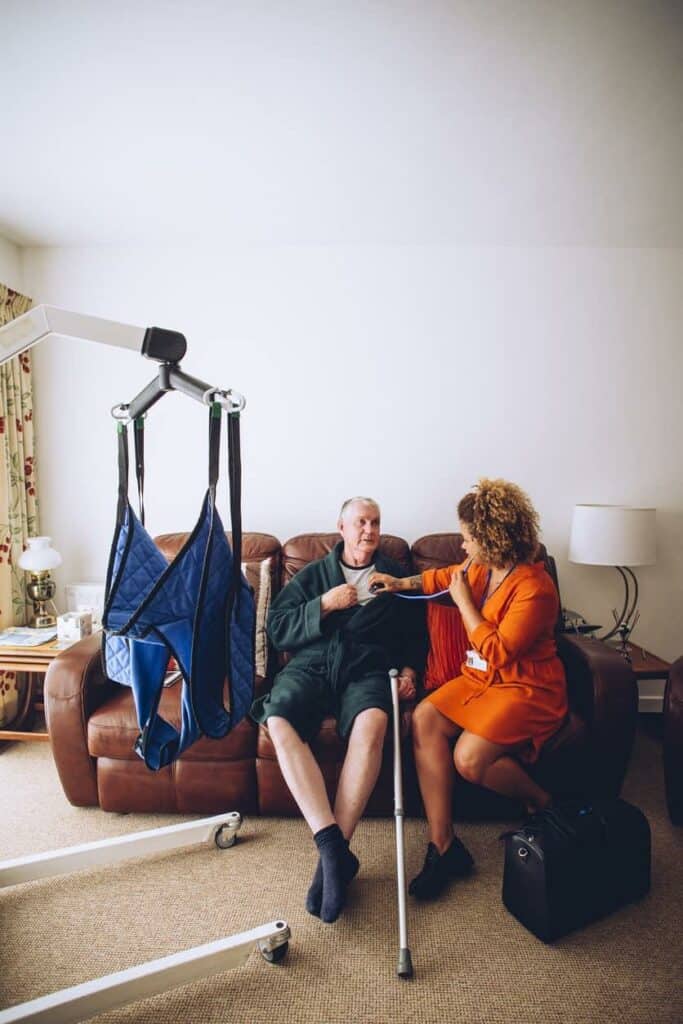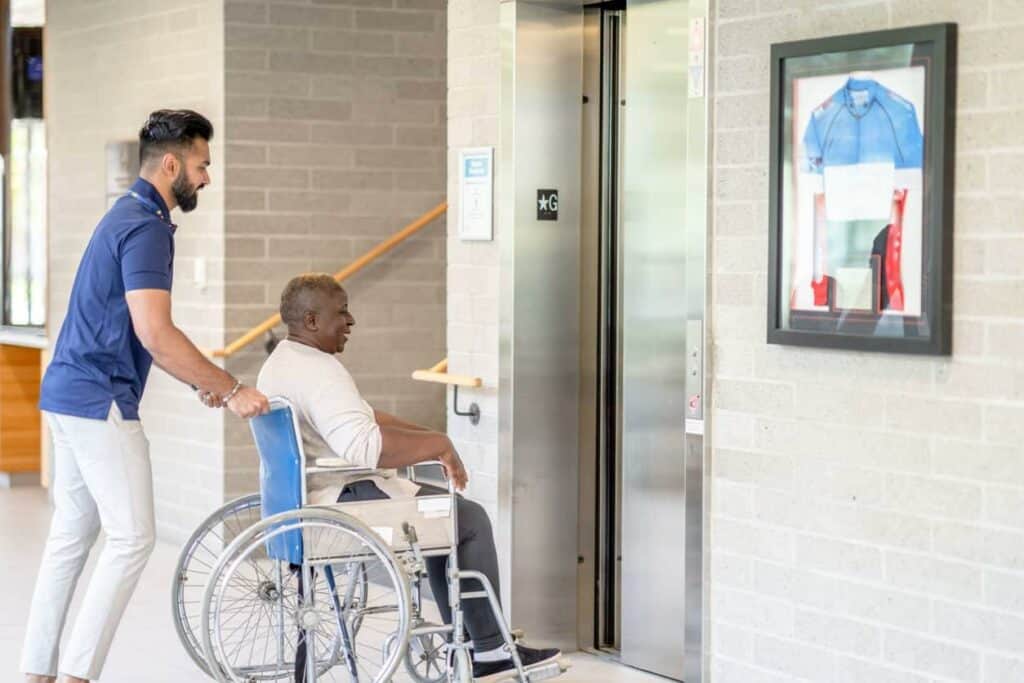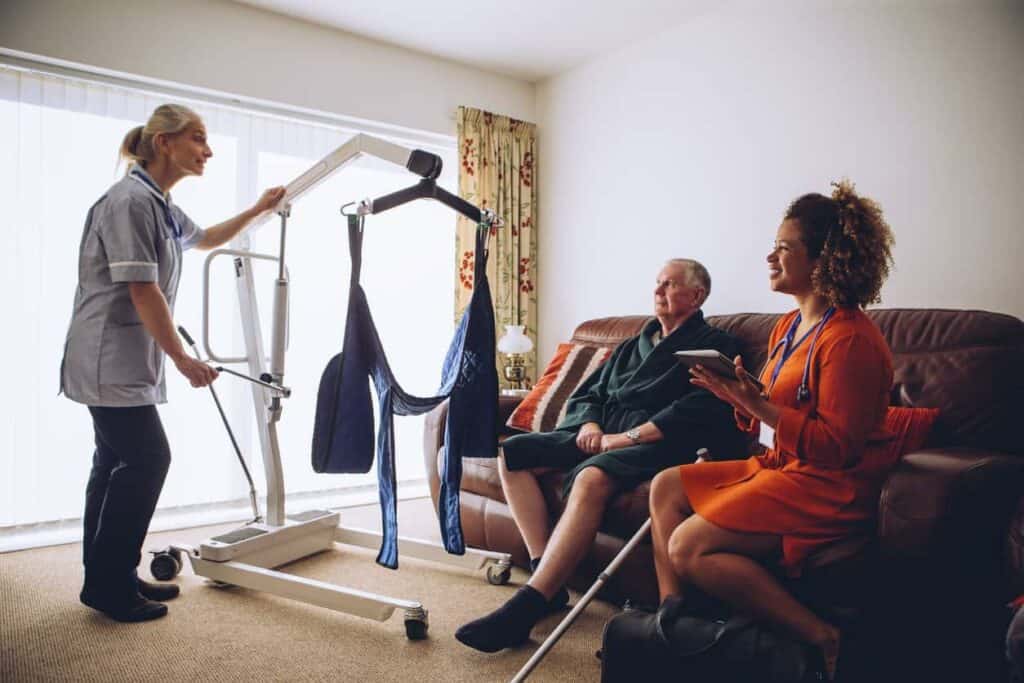
Is your elderly loved one receiving enough care? Does this help them live more independently? Adequate senior care is vital for many reasons, as it promotes autonomy, independence, and mobility for people with physical limitations. Busy family caregivers gain time and resources to accomplish their other roles without hitches with an extra caregiving hand.
When you hire a reliable caregiver from Amy’s Eden, we can assist your loved one in using their mobility devices, such as portable Hoyer lifts, and help them move around. Portable Hoyer lifts are patient lifts you can carry anywhere. It’s a variation of a standard Hoyer lift, except that it’s foldable, allowing diverse mobility options. Find out more about these types of medical lifts, plus factors to consider when buying the equipment.
Understanding Portable Hoyer Lifts

A portable Hoyer lift will enable you to help a loved one with mobility concerns move whenever, wherever. Several cases of unwanted injuries occur when transferring patients from a resting surface, bed, wheelchair, and other areas of the home.
Moving your loved one poses health risks for them and their caregiver. Hence, proper education and training in operating a portable Hoyer lift is integral. These assistive devices help drive down the risk of unnecessary accidents to zero if operated properly.
Benefits of Portable Hoyer Lifts

Like other mobility aids in the market, Hoyer lifts come in a wide range of options to suit your loved one’s unique needs. Hoyer lifts are substantially useful, but they can be bulky. The portable ones are perfect if you’re looking for the following advantages.
Easy to Store
Standard Hoyer lifts occupy storage space. For instance, if you want your senior mom to visit a nearby park, it might not fit in the back of the car. A portable Hoyer lift addresses this shortcoming. Since it’s foldable without needing extra tools, you can store it under the bed, in a corner, or in the vehicle’s trunk if you want to bring it when traveling. It’s a storage saver; you can carry it anywhere.
A Wider Range of Motion
A portable Hoyer lift stands out due to its wider range of motion, which is considered an unparalleled feature. The device’s boom or the horizontal arm extending from the mast is adjustable and can go all the way down to the ground, which is useful when moving your loved one from the floor back to a higher bed. It’s handy if they do rehab exercises or play with their grandchildren on a mat.
Tapered Legs
Another unique feature of the portable variant is its narrowing legs that give you the option to widen the stance of the lift for more base support and stability. Additionally, it helps clear away obstacles during transfer.
Smooth Maneuvering
It’s also equipped with a push pad that gives caregivers control in operating the lift, guiding it, and moving it forward or backward for a safe and successful transfer.
3 Types of Portable Hoyer Lifts

Portable patient lifts come in different models, sizes, and specifications to meet the patient’s unique needs. Here are the three types.
1. Compact Hoyer Lifts
These are smaller than other models, making them ideal for tight spaces or small rooms. Their lightweight design and easy maneuverability make them convenient for travel and transport.
The benefit of a compact lift is its versatility, as it can be used in various settings, such as at home, in hospitals, or even during outings. They are suitable for individuals who require assistance with mobility but may not have a lot of space.
2. Mini Hoyer Lifts
Mini lifts are even smaller and more portable than compact lifts. These lifts are designed for easy folding and transport, making them perfect for individuals who frequently travel or have limited storage space.
Despite their compact size, mini lifts still provide the necessary strength and stability to transfer individuals safely. Mini lifts are suitable for situations requiring constant movement or travel, such as for individuals who frequently change locations or need to use lifts in different rooms.
3. Collapsible Hoyer Lifts
They have a unique feature where they can be easily disassembled and folded, allowing for compact storage and transport. These lifts are the most portable option and are often used by caregivers who need to carry them in vehicles or store them in small spaces.
Collapsible lifts are preferred for situations where space limitations are a concern or for caregivers who need to take the lift on the go. They provide convenience in terms of storage and transportation without compromising functionality or safety.
In summary, the differences in size and portability of the three types of Hoyer lifts cater to specific needs. Compact lifts are versatile and can be used in various settings, mini lifts are ideal for frequent travel, and collapsible lifts offer maximum portability and storage convenience. The choice should be based on the available space, transportation requirements, and the specific needs of the individual requiring assistance.
Key Features and Considerations

As each type of portable Hoyer lift has a particular use, you need to know what factors to consider when choosing the right assistive tool. Keep these five things in mind.
Weight Capacity and Range
Like standard medical lifts, the patient’s weight and the range of motion necessary for intended use are vital when selecting a tool.
Compact Hoyer lifts are ideal for maneuvering in tight spaces, so their range of motion is more restricted than collapsible or mini types. Consider where and the situation you’re going to use the lift and your loved one’s body size and weight.
Design and Portability
You can carry portable Hoyer lifts everywhere, but the collapsible kind is better if you want extra comfort when traveling. You can fold and store it conveniently in the car. The mini or compact type can do the job if you want an easy-to-carry lift for everyday use.
Remember the design is also as essential as portability, so choose your options appropriately. If you need to optimize maneuverability in a few square feet of space, compact Hoyer lifts are designed and capable for that purpose.
Safety Features
Another essential consideration is the safety features. Pick one that is easy to maneuver and operate and doesn’t require complex operations. Above all, get your loved one a lift suitable for their body size and weight to make transferring safe.
Part of the lift’s safety manual is training the primary or family caregiver on its proper use in various situations, such as lifting a loved one from the floor to the bed, toilet, and other home areas.
Ease of Use and Maintenance
Schedule regular maintenance checks to keep your travel lift in optimal working condition. Inspect the lift for any signs of wear and tear and immediately address any issues to prevent safety hazards.
If you don’t know how, hire a qualified technician to check the equipment visually. Manufacturers often have written points for these professionals to follow when inspecting the lift, including its battery performance, safety limit switches, and charging system. They can help diagnose whether it needs repair.
Accessories and Optional Features
Hoyer lift accessories include different types of lift slings for specific transfer, replacement knee pads, and sling chains. As these add up to the cost, choose quality ones you can use for a long time.
Choosing the Right Portable Hoyer Lift

Picking the suitable lift for your senior mom or dad can feel overwhelming if you’re faced with a myriad of equipment options when shopping. But in a nutshell, the right lift is one that supports safe transfers. How do you know if you’re getting the correct lift? These suggestions can guide your choice.
Assess Senior Care Needs
Each option of the portable Hoyer lift serves a particular purpose and is designed to meet specific patient needs. You’d want to get a lift your loved one can use comfortably and safely. Like how you shop for footwear with the correct shoe size, approach buying a portable Hoyer lift in a manner that satisfies their unique needs with the right features, like appropriate weight capacity and range.
Consulting with Healthcare Professionals
Consulting with healthcare professionals is invaluable as they can advise on the most suitable lifting equipment tailored to the individual’s needs. They’re the best person to elicit advice from regarding these tools, especially if it’s your first time buying a Hoyer lift.
Evaluating Budget and Cost-Effectiveness
On top of that, you must be aware of Medicare and other health insurance coverage for Hoyer lifts your loved one may have. While not all costs may be covered, understanding your options can help make shopping for senior care equipment convenient and less stressful. If you know it’s covered, you can expand your options to better lifts with additional features you can use for the long term.
Reading Customer Reviews and Comparisons
Thanks to online stores, you can read buyer reviews and compare different types of Hoyer lifts to further whittle down your options to only the best. Companies will typically present their products in a good light, undermining the downsides.
But reviews and testimonials will give you insight into what product features others find valuable and unnecessary, or what they think can be improved. For instance, reading a review that says they’ve only used the lift for a month before they need to send it for repair will make you rethink whether that model will be a practical buy.
Considering Long-Term Benefits
Above all, senior care equipment is an investment you can use for the long term. Hence, taking your time, researching, and asking for others’ feedback will help you decide which is the best lift for your senior parents.
Proper Use and Safety Guidelines

To make the most of your portable Hoyer lift while ensuring comfort and safety, keep the following precautions in mind:
Understanding Lift Instructions
Although made by the same company or brand, each type of Hoyer lift comes with a manual detailing the safe operating instructions.
You must understand and participate in the training with your healthcare provider or manufacturer to know how to maneuver the lift while eliminating safety risks. Quickly check out on YouTube if the company has included a video tutorial on operating the equipment so you can familiarize yourself with its use.
Awareness of the Patient’s Physical Condition
In doing transfers, another consideration is the patient’s overall physical condition. While some seniors can have some level of mobility and independence and can sit or stand without assistance, others may be too frail to move their hands or legs, making a transfer risky.
Provide adequate mobility support if a loved one depends on you or the caregiver’s help for moving.
Ensuring Proper Sling and Harness Use
Before moving or lifting, always double-check if the sling and harness are secure to support a safe transfer from a bed to a wheelchair or vice versa. Moreover, remember to ask your senior mom or dad if they’re comfortable with how the sling is attached to their body, ensuring they have the correct position before transferring. Otherwise, you’ll have to adjust the sling or reposition them to avoid injury.
Regular Maintenance and Inspection

A patient lift is a medical equipment that requires regular maintenance. Wipe down any debris or spills. Always visually inspect the lift before each use and look for signs of damage, loose parts, or issues that can make using it unsafe. You can also have a qualified technician to test or inspect it, say, every week or month, to ensure it’s always in good working condition.
Training Caregivers and Family Members
The rest of the family members must also learn the standards of operating a lift so you can assist your loved one whenever the caregiver is not around. Make it a family affair by getting everyone involved in your loved one’s health.
Additional Resources and Support
A quality portable Hoyer lift is a financial investment. Here are some ideas on how and where to get help, get answers, or ask for advice when purchasing a lift.
Online Stores and Retailers
Many online stores and retailers have specialists or knowledgeable representatives who can give recommendations based on your loved one’s needs. These people are trained in the different uses and purposes of medical lifts. You can get an appropriate recommendation as long as you can provide precise information on what you’re looking for, including your loved one’s height, weight, and physical limitations.
Customer Service and Technical Support
If you have billing concerns and questions on how to operate or troubleshoot a lift, contact the manufacturer’s customer service or technical support team. These people are experts at diagnosing and repairing issues with your medical equipment.
Return Policy and Warranty Information
Depending on the model, Hoyer lifts are usually guaranteed for two years starting from the date you receive the equipment. The warranty covers defects on both mechanical and electrical components under normal use.
If you need clarification on the warranty information, contact the supplier. When you receive the lift, a manual and a warranty card will be included. Keep these in case you need to use them in the future.
Available Accessories and Parts
Similarly, contact the supplier’s customer service department if you need a replacement part. Check the warranty card or instruction manual for a contact number or email to call or message the supplier.
Community Forums and Support Groups
There are online forums and caregiver support groups, such as StrokeOT, a nonprofit organization that provides resources to caregivers, including how to use Hoyer lifts and other types of transfer and assistive equipment. You can find such groups on social media, local caregiving communities, and home care agencies like Amy’s Eden.
A Portable Hoyer Lift Can Improve Your Loved One’s Mobility
What sets a portable Hoyer lift apart from other lifts in the market is it’s designed to be compact, lightweight, easy to carry, yet fully functional.
Unlike bulky medical equipment you can only use in restricted settings, like at home or in a hospital, you can bring a portable medical lift anywhere and use it anytime.
Need to visit a family relative out of state? The collapsible Hoyer lift can fit right into the car’s trunk or backseat and is always ready for use.
More importantly, if you ever need a reliable caregiver who can use a portable lift safely, Amy’s Eden is ready to help. We have trained caregivers who can safely support transfer and provide mobility assistance to seniors with varying care needs. Find a caregiver near you today.




